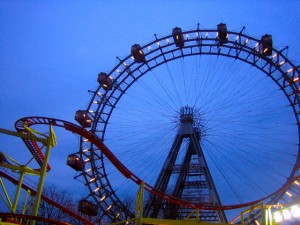“My Grandmother always used to say to me, ‘When you die, they’re gonna give that mouth of yours its own funeral.’ [But] a person can change. Because today I am the epitome of silence….I’m far more interested in the nice people now, the quiet ones, the normals, the ones who you’d say—they lead their regular lives.”
In the wake of the popularity of Scandinavian mystery writers like Jo Nesbo, Arnaldur Indridason, Henning Mankell, Jussi Adler-Olsen, and Stieg Larsson, this mystery by wildly popular Austrian novelist Wolf Haas has just been translated into English, the first of seven novels featuring Si mon Brenner to be available in the U.S. Over two million copies of that series have been sold in Germany alone, with additional hundreds of thousands sold in the rest of Europe, Korea, and China. Though Haas’s novels have been described elsewhere as belonging to the noir mystery genre associated with the previously named, more famous authors, this novel is actually quite different from those. Here the novel’s smart-alecky and in-your-face first person narrator, with his appreciation of irony and his uniquely hilarious observations, keeps the reader smiling even as horrific murders are taking place. The narrator himself does not appear to take the characters in his story seriously, and the novel’s resulting style is closer to that of an “entertainment” or farce, in which the narrator becomes the main character directing the show, than it is to the dark and often cynical mysteries clearly identifiable as “noir.”
mon Brenner to be available in the U.S. Over two million copies of that series have been sold in Germany alone, with additional hundreds of thousands sold in the rest of Europe, Korea, and China. Though Haas’s novels have been described elsewhere as belonging to the noir mystery genre associated with the previously named, more famous authors, this novel is actually quite different from those. Here the novel’s smart-alecky and in-your-face first person narrator, with his appreciation of irony and his uniquely hilarious observations, keeps the reader smiling even as horrific murders are taking place. The narrator himself does not appear to take the characters in his story seriously, and the novel’s resulting style is closer to that of an “entertainment” or farce, in which the narrator becomes the main character directing the show, than it is to the dark and often cynical mysteries clearly identifiable as “noir.”
What is most unusual is that the chatty unnamed narrator is NOT Simon Brenner, who is ostensibly the main character. Brenner, a former policeman, is now working as a chauffeur for “The Lion of Construction,” a fifty-year-old man named Kressdorf, who runs a major development company with offices in Munich. Kressdorf’s much younger wife, a physician, works in Vienna, where she operates a clinic offering abortion services. The Kressdorfs’ two-year-old daughter Helena needs to be ferried back and forth regularly between Munich and Vienna so that both parents can share her company during the work week, and Brenner, known as “Herr Simon” to Helena, loves this new life and his very special relationship with Helena. In fact, he spends so much time driving with her that her first words are not “Da-da,” or “Ma-ma” but “Driver.”
 On one occasion, however, Brenner fails to fuel the limo ahead of time. When he stops for gasoline, he goes inside the station to buy Helena a candy bar and gets sidetracked. By the time he returns to the car, Helena is gone. There is no dearth of suspects in the kidnapping since both parents have serious enemies. Kressdorf, the father, is working on a huge development project, MegaLand, which many citizens oppose but which certain well-paid government officials support. In Vienna, a group of militant pro-lifers led by a man named Knoll have been trying to oust Kressdorf’s wife and her clinic from their medical office, buying up all the surrounding office space and installing surveillance cameras as intimidation. After Brenner is fired from his job, he ignores orders from the police, some of whom he knows, and decides to track down the kidnapper himself. Uncovering secrets surrounding both of the parents and the people who work for them, Brenner trails suspects, breaks into buildings, and searches for a reason to explain why there has been no ransom. As he investigates, he becomes involved in a number of gory deaths.
On one occasion, however, Brenner fails to fuel the limo ahead of time. When he stops for gasoline, he goes inside the station to buy Helena a candy bar and gets sidetracked. By the time he returns to the car, Helena is gone. There is no dearth of suspects in the kidnapping since both parents have serious enemies. Kressdorf, the father, is working on a huge development project, MegaLand, which many citizens oppose but which certain well-paid government officials support. In Vienna, a group of militant pro-lifers led by a man named Knoll have been trying to oust Kressdorf’s wife and her clinic from their medical office, buying up all the surrounding office space and installing surveillance cameras as intimidation. After Brenner is fired from his job, he ignores orders from the police, some of whom he knows, and decides to track down the kidnapper himself. Uncovering secrets surrounding both of the parents and the people who work for them, Brenner trails suspects, breaks into buildings, and searches for a reason to explain why there has been no ransom. As he investigates, he becomes involved in a number of gory deaths.
Haas’s narrator is continuously witty, making casual comments which readers will love. In grousing about the impolite and arrogant attitudes of children these days, he remarks that “Kids nowadays grow so fast you can’t use size as a point of reference anymore—Is that the chief physician striding out of the maternity ward, or is it the newborn itself? Even then it’s the exact opposite of how it used to be—Rule of thumb , the less arrogant one’s the physician.” When he surveys the abortion clinic, he notes that “there was never a riotous crowd in front…but somehow the silent threat from the church-types was even more menacing, because there’s nothing worse than a sighing aggressor. A well-known fact: behind every mass murderer there’s a mass sigher.” The author pays lip service to major themes as Brenner, throughout the novel, half-heartedly tries to consider big issues, such as when life begins, whether there is a God, and how much He may control what happens in life, but most readers will be repulsed by the conditions under which Brenner believes he finally sees God and the inescapable conclusion.
, the less arrogant one’s the physician.” When he surveys the abortion clinic, he notes that “there was never a riotous crowd in front…but somehow the silent threat from the church-types was even more menacing, because there’s nothing worse than a sighing aggressor. A well-known fact: behind every mass murderer there’s a mass sigher.” The author pays lip service to major themes as Brenner, throughout the novel, half-heartedly tries to consider big issues, such as when life begins, whether there is a God, and how much He may control what happens in life, but most readers will be repulsed by the conditions under which Brenner believes he finally sees God and the inescapable conclusion.
Despite the wry and often pointed commentary about contemporary life, the novel’s style can be awkward. The narrator is sometimes too helpful with his information and goes on too long, saying things like, “Listen carefully. You need to take note of the following: the difficult thing about a kidnapping is always the ransom handover. If that weren’t true, everybody would be kidnapping everybody else. It would be paradise on earth…no one would have to work anymore…” And at one point, whe n only a couple of murders have taken place, the narrator self-consciously reminds himself that “If he’d just [paid attention] the entire solution probably would have presented itself, and [X number of] people wouldn’t have had to die.” Suspense about the number of future murders is sacrificed here to the narrator’s second-guessing about his own actions, suggesting that the author is having more fun with his narrator than with the story itself.
n only a couple of murders have taken place, the narrator self-consciously reminds himself that “If he’d just [paid attention] the entire solution probably would have presented itself, and [X number of] people wouldn’t have had to die.” Suspense about the number of future murders is sacrificed here to the narrator’s second-guessing about his own actions, suggesting that the author is having more fun with his narrator than with the story itself.
A final caveat. Those of you who have read Jo Nesbo’s Headhunters will undoubtedly remember one of the most repulsive scenes in recent noir writing, as the main character finds a unique way to hide from someone determined to murder him. Though no one can “enjoy” this scene, it somehow fits with the gloomy mood of Nesbo’s very dark novel. In this novel, however, Haas uses exactly the same repulsive setting for several murders and one attempted murder. Given the playful mood and decidedly casual demeanor of the narrator throughout, despite the number of murders, the use of that setting in this novel feels less absurd and less like noir, and more like an attempt at adolescent bathroom humor, made over and over and over again. An unusual novel with even more unusual point of view.
Photos, in order: The author’s photo appears on http://blog.tt.com
Helena loved the Lilliput train at Prater Park in Vienna, and her father used to take her there, though he would never stay as long as she wanted. Brenner indicates he would have loved to take her and would have stayed as long as she wanted.
http://freizeitparkweb.de
Brenner has often met Kresssdorf at a cafe at the Prater, near the Giant Wheel, the Riesenried, a giantic 212′ diameter Ferris wheel built originally in 1897. Though it was damaged in World War II, it remains basically intact, with 15 gondolas instead of the original 30. It is included in a famous scene from the film of THE THIRD MAN, with Joseph Cotten and Orson Welles. http://kimwood.org
ARC: Melville House
